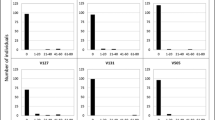Abstract
As larval forms of Fasciola hepatica have periodically been detected in Omphiscola glabra after their collection from watercress beds or from meadows since 1995, field investigations in 37 populations of O. glabra were carried from 1996 to 2002. This was done in order to determine the changes in prevalences and intensities of these natural infections with F. hepatica in relation to the type of snail habitat and the year of snail collection. Snails infected with F. hepatica were found in all samples made in swampy meadows and roadside ditches in all years. In fenced pools and walled gardens, snail infections were only found from 1998 and 1999 onwards, respectively. In the four types of habitats, the prevalences of F. hepatica infections increased slightly over time (0.8–2.1% for snails sampled in swampy meadows, for example) but this increase varied with the habitat. The mean shell heights of infected snails (6.2–7.8 mm) were similar whatever the type of habitat. The numbers of cercariae-containing rediae counted in snails sampled in swampy meadows, roadside ditches, and fenced pools significantly increased over time. Significant numerical variation between these redial burdens was also observed in relation to snail habitat. As the larval development of F. hepatica is facilitated by the presence of another trematode larval form (Paramphistomum daubneyi), the finding of some naturally infected O. glabra in watering places known to have no contact with domestic or wild large mammals might be explained by the development of P. daubneyi in small mammals such as lagomorphs. However, a progressive adaptation of F. hepatica miracidia to O. glabra over time, which would permit the infection of snails at sizes larger than 2 mm, could not be excluded.
Similar content being viewed by others
References
Abrous M, Rondelaud D, Dreyfuss G (1996) Paramphistomum daubneyi and Fasciola hepatica: the effect of dual infection on prevalence and cercarial shedding in preadult Lymnaea glabra. J Parasitol 82:1026–1029
Abrous M, Rondelaud D, Dreyfuss G, Cabaret J (1999) Infection of Lymnaea truncatula and Lymnaea glabra by Fasciola hepatica and Paramphistomum daubneyi in farms of central France. Vet Res 30:113–118
Abrous M, Rondelaud D, Dreyfuss G (2000) A field study of natural infections in three freshwater snails with Fasciola hepatica and/or Paramphistomum daubneyi in central France. J Helminthol 74:189–194
Alabay L (1982) Comparative diagnostic studies on Paramphistomum cervi infections in sheep with the immunoperoxydase (ELISA) and indirect immunofluorescence (IFAT) techniques. Vet Bull 52:7050
Boray JC (1978) The potential impact of exotic Lymnaea spp. on fascioliasis in Australasia. Vet Parasitol 4:127–141
Bouix-Busson D, Rondelaud D (1986) L’infestation de Lymnaea glabra Müller par Fasciola hepatica L. Etude expérimentale sur le terrain. Ann Parasitol Hum Comp 61:215–225
Kendall SB (1950) Snail hosts of Fasciola hepatica in Britain. J Helminthol 24:63–74
Mage C, Bourgne H, Toullieu JM, Rondelaud D, Dreyfuss G (2002) Fasciola hepatica and Paramphistomum daubneyi: changes in prevalences of natural infections in cattle and in Lymnaea truncatula from central France over the past 12 years. Vet Res 33:439–447
Rondelaud D, Dreyfuss G (1998) L’infestation naturelle de Lymnaea glabra par Fasciola hepatica dans deux cressonnières naturelles de la Haute-Vienne. Bull Soc Fr Parasitol 16:291–297
Rondelaud D, Vignoles P, Abrous M, Dreyfuss G (2001) The definitive and intermediate hosts of Fasciola hepatica in the natural watercress beds in central France. Parasitol Res 87:475–478
Stat-Itcf (1988) Manuel d’utilisation. Institut technique des céréales et des fourrages, Service des études statistiques, Boigneville, France
Author information
Authors and Affiliations
Corresponding author
Rights and permissions
About this article
Cite this article
Dreyfuss, G., Vignoles, P. & Rondelaud, D. Natural infections of Omphiscola glabra (Lymnaeidae) with Fasciola hepatica in central France. Parasitol Res 91, 458–461 (2003). https://doi.org/10.1007/s00436-003-0892-8
Received:
Accepted:
Published:
Issue Date:
DOI: https://doi.org/10.1007/s00436-003-0892-8




